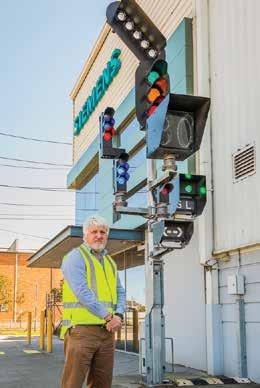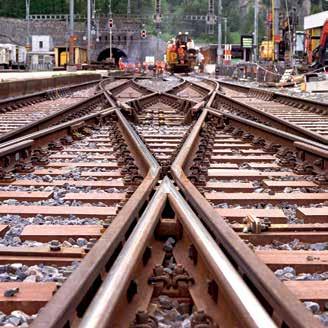
7 minute read
GS1 helping digitalise supply chain management
from REX Dec 2019
by Prime Group
The digitalisation of supply chain management
“My message to all those involved in the rail industry whether you are a small supplier, all the way through to us as a big maintainer, is get on board with i-TRACE.”
Essentially, standardising the way materials in the rail industry supply chain are identified and marked enables “traceability and warranty management, which is fundamental for lifecycle tracking,” according to Stephen Baker, head of product innovation at Siemens Mobility in Australia.
“This has always been a challenge for the industry,” Baker said.
Under Project i-TRACE, identification codes compliant with GS1 standards are encoded into a machine-readable GS1 DataMatrix barcode, usually directly laser-engraved. According to GS1, an engraved barcode is the best option in harsh environments where labels are likely to fall off, such as for rolling stock. One GS1 client developed a process whereby the DataMatrix barcode could be vulcanised into rubber parts, for others a sticker label is enough.
Once the barcode has been affixed, product data T HE DIGITALISATION OF SUPPLY chain management is well underway across a range of industries, and GS1 Australia says it is committed to making this process easier for the rail sector. As a not-for-profit provider of standards and solutions for over 20 industry sectors, GS1 introduced barcoding to Australia in 1979 to enable its more than 20,000 member companies to implement their standards more efficiently. The barcodes are now scanned across the world over six billion times daily. When the rail industry agreed in 2015 that GS1 standards were the right choice to enable best practice supply chain management, the Australasian Railway Association (ARA) led industry working group initiated Project i-TRACE to help implement consistent identification (globally unique codes) and automatic data capture (barcoding) in organisations and value chains across the rail industry.
Efficiency within the rail industry is heavily reliant on successful supply chain management practices. Assuring material availability of the right quantities, the right qualities, at the right place and time with minimum effort and cost is crucial.
Stronger life cycle traceability is needed for this, and best practice requires the uptake of the innovative technologies that are disrupting the sector.
“Around the world there is a realisation that the digitalisation of the rail industry is essential. Project i-TRACE is a fundamental building block towards achieving digital capability in the sector,” ARA CEO, Danny Broad, has said.
Project i-TRACE allows all stakeholders within the supply chain to follow a component, part or asset throughout its lifecycle (including maintenance) from procurement to disposal with ease. It is intended to help stakeholders identify products, electronically capture information about them and then share that information with relevant parties.
GS1 supplies a tracking technique to give a unique identification to all rail products including items such as point machines, tracks and signalling parts. “Project i-TRACE allows us to trace every component from when it’s been manufactured all the way through to installation and to the whole of life performance of that asset,” Sydney Trains chief executive officer Howard Collins said when Sydney Trains began its digitalisation. Stephen Baker, head of product innovation of Siemens Mobility in Australia. When the Australasian Railway Association announced the industry-wide adoption of GS1’s ISO data standards in 2015, Project i-TRACE was established to help industry with their implementation across all stakeholder companies. Head of product innovation at Siemens Mobility, Stephen Baker, spoke to Rail Express about Siemens Mobility’s Project i-TRACE journey.
can be read by using a scanner or smartphone with the appropriate software application installed.
While Siemens Mobility is still in the process of implementing Project i-TRACE, Baker says the benefits of implementation are obvious.
“We’ve been able to laser engrave unique IDs onto black plate which are then placed on a product, which takes less than two minutes.”
“Automating the manual processes saves time and eliminates the possibility of human error. The field technicians are then able to capture the maintenance history of these products while on site, which makes it so much easier and improves efficiency.”
Other benefits include reducing inventory write-offs and waste leading to optimal inventory management, improving maintenance and repair operations, and reducing cost with fewer transaction errors and better data quality.
“We see Project i-TRACE as an enabler,” Baker said. With Internet of Things (IoT) innovations allowing components to become smart, interconnected and capable of talking to each other for essential data capture which allows the monitoring of the performance of items, these components however need to become consistently identifiable.
“It’s easy enough to capture data in stock management, but how are you going to identify which component you are capturing?”
“GS1 gives us the building blocks to implement these processes.” “i-TRACE is quick, and it’s comprehensive. It gives us access to all the necessary information, and we can understand the behaviour of our systems by looking closely into the analytics of the product’s lifecycle. For example, where before the only information you could get about a railway signal was that it was a railway signal, with i-TRACE you can now use the unique product ID to see an entire data matrix of information.”
“With this ecosystem of knowledge, you can ensure best practice quality control, maintenance and accountability to your clients through a more agile process.”
While Project i-TRACE was designed to enhance


supply chain management, for Baker it is more than that.
“For most, GS1 compliance is about getting the products to the end-user, but we see it as going beyond that. Once a product has been marked, it’s an asset,” he explained.
“Traceability helps organisations provide a better service to their clients, with improvements to the maintenance and repair of assets. Implementing i-TRACE in our rail sectors will make railways easier and quicker to repair and cause a flow on effect to service delivery, helping reduce commuter disruption if things go wrong.”
“Asset management is amazingly complex, the digitalisation enabled by Project i-TRACE makes it easier,” Baker said.
Especially for a manufacturer of safety equipment, wherein the high levels of accountability GS1 enables are vital.
While Siemens Mobility is still in implementation mode, as one of the first in the industry to take part in the project which they commenced in March 2018, Baker has advice for organisations who want to implement the solution.
“The first step is budgeting, because the biggest challenge is the allocation of funding. Implementing Project i-Trace can be scaled up or down depending on the size of your organisation,” he said.
For a small trader it’s simply a matter of adding the unique ID to a docket, whereas for Siemens it was possible to use more sophisticated machinery. Products get marked at downstream. The key at this stage, during budgeting, is to have a good business case according to Baker, who recommends hiring expert consultants to provide the necessary analysis. The next step is the project plan.
“We began with a deep review of the process, got sign off on the business case and in the months following, started our internal working group. In 2019, our internal working group and internal activities with our program were being finalised and we received our unique marking machine for over 18,500 trackable items to be marked at our Port Melbourne manufacturing facility.”
While compliance with GS1’s standards is necessary, having been determined as enabling best practice by the ARA and industry representatives, implementation has been made all the easier for organisations of all sizes by GS1’s Project i-Trace. Stephen Baker sees Project i-TRACE as an enabler.
FFU ™ high performing synthetic bridge transoms and turnout bearers

1.500 km safety! 39 years FFU ™ synthetic sleeper


Transom Design specified by TfNSW
Shinkansen is running on FFU since 1988 300 km/h

State of the Art RAILWAY TECHNOLOGY













